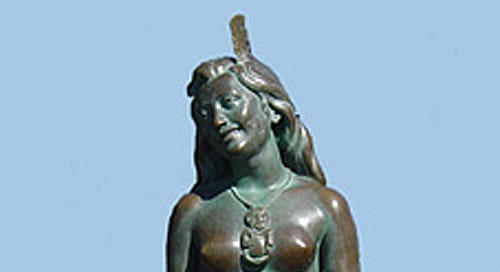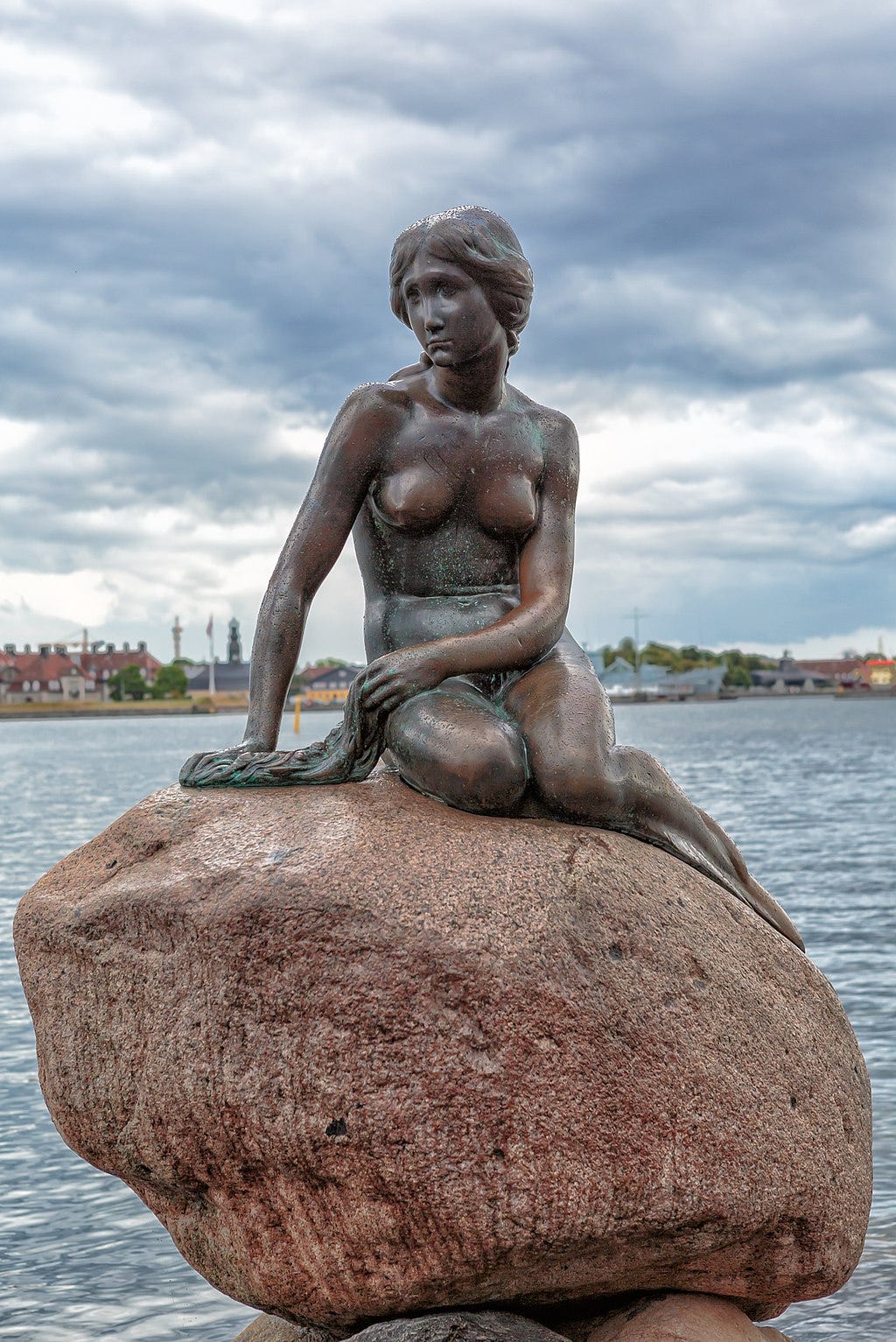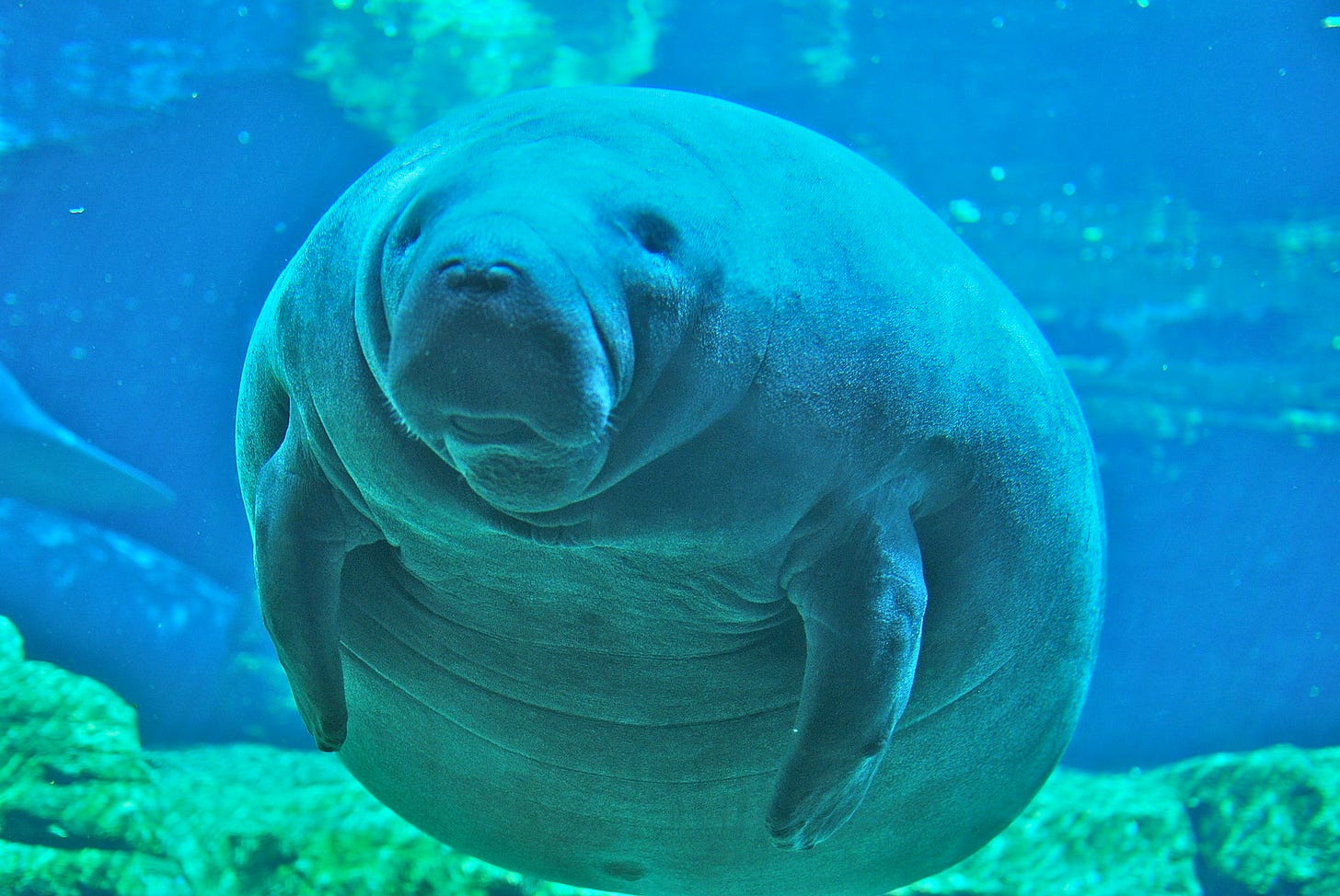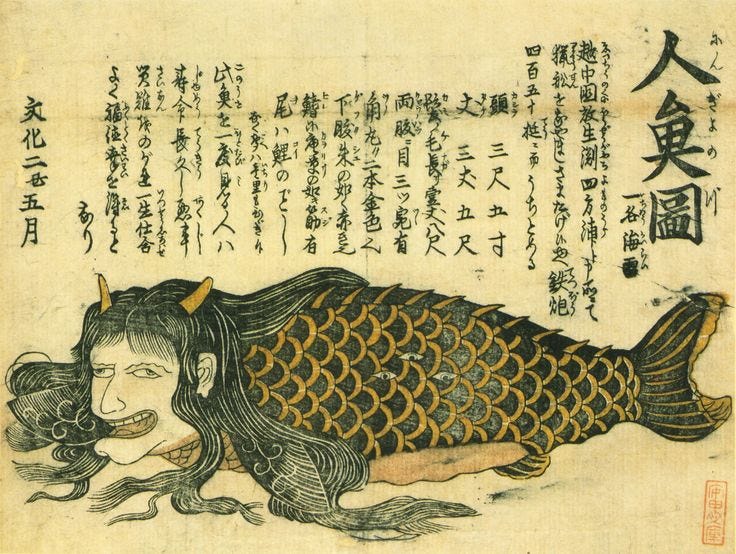Often women are anthropomorphised as mermaids. Anthropomorphism is the attribution of human traits and emotions to animals or non-human entities. It is considered to be an innate tendency of human psychology. Water has always been associated with the feminine principle. In the French language, the sea is gendered, “la mer”. In tales of mermaids, men are often lured by her beauty or sweet voice. The New Zealand Māori story of the mermaid Pania is told something like this:
At sunset, the beautiful mermaid Pania, would swim into the bay of Napier, up a stream and then rest. Karitoki, the handsome son of a chief, came to drink at this stream every evening. He was unaware that Pania was watching him from among the flax bushes. One evening Pania put a spell on Karitoki, who then saw her in her hiding place. They instantly fell in love with each other. They were secretly married and she went to his house, but she had to return to the sea each sunrise. He tried to stop her, but she explained to him that she would die if she did not go, but she promised to return every evening. Karitoki consulted a kaumatua (wise elder) in the village what he could do. The kaumatua told him that Pania would not be allowed to return to the sea if she swallowed cooked food. That night, as Pania slept, Karitoki took a morsel of cooked food and put it in her mouth. Ruru the owl warned Pania and she awakened. Upset that Karitoki put her life in danger, Pania fled back to the sea. Karitoki swam into the ocean looking for her, but he never saw her again.
This small mermaid statue has been in Copenhagen, Denmark since 1913. It was commissioned by Carl Jacobsen, who was fascinated by the ballet presentation of the fairytale by Hans Christian Anderson. This version of the mermaid tale is a story of self-sacrifice for love. The end of the original 1837 book differs from the Disney version. The story can be summarised as follows:
The Little Mermaid sees a prince, falls in love and then rescues him from a shipwreck. The Little Mermaid sacrifices her comfortable life as a mermaid in order to transform into a human to win the affection of the prince. She enters into a pact with a sea witch to exchange her tongue and beautiful singing voice for a pair of legs. Once on land, the prince sees her as a mute pet and he ends up marrying someone else. The little mermaid learns her lesson and becomes an air sprite.
The Arabian collection of folk tales, One Thousand and One Nights has tales featuring “sea people” such as Jullanâr the Sea-born and her Son King Badr Básim of Persia. They are sea-born humans who interbreed with land humans, and can live and breathe underwater. In the tale, “Abdullah the Fisherman and Abdulla the Merman”, the fisherman gains the ability to breathe underwater and discovers an underwater society that is portrayed as an inverted reflection of society on land where money and clothing do not exist.
Other mermaid tales from around the world:
kulullū/kuliltū— kuliltū means “fish woman”. This is the earliest depiction of mer people with fishtails on Babylonian cylinder seals
Atagaris / Derketo— Dea Syria, or in one word Deasura. This is the oldest mermaid tale of a Phoenician/Assyrian goddess who accidentally kills her mortal lover Hadad. Distraught, she throws herself into a lake but the gods save her by turning her into a mermaid.
Queen Semiramis — The goddess Derketo’s daughter, was the fish-tailed wife of Oannes. Alternatively, Oannes was described in cuneiform tablets as the fish-man, or apkallu. In the 2nd century AD, Lucian the Syrian satirist wrote a book about the Syrian Goddess equating her to the goddess Hera. Her statue at Hierapolis Bambyce was fully human.
Aycayia — The Taino indigenous people of the Caribbean associated this mermaid with the hibiscus flower. She represents wealth and beauty. The Haitians call her La Sirene, and she is also revered in Cuba, Puerto Rico, and West Africa.
Māe-d’agua or iara, “lady/mother of the water” is the beautiful Brazilian mermaid who seduces fishermen with her enchanting voice.
Mami Wata— This African mermaid is revered in Benin, Ghana and Togo. She lures sailors down to her watery depths. If she returns them to land, they gain spiritual insight and become attractive and successful.
Hwang-ok— A Korean princess from Naranda from a mythical undersea kingdom of mermaids. She is based on the historical Hwang-ok from India.
Sinjike— On the South Korean island of Geomundo, this mermaid can predict the weather and she warns fishermen of impending storms by singing and throwing rocks into the sea.
Ningya— Japanese “human fish” which has a human face and a fish body, which could be a depiction of a manatee.
Ama — Female Japanese skin divers, who for over 2,000 years have been diving for shellfish and seaweed wearing only a loincloth have been romanticised as mermaids.
Jiaoren— Chinese “shark people” mentioned in the Bowuzhi as having weeping tears that become pearls.
Suvannamaccha — The golden mermaid daughter of Ravanna who appears in Cambodian and Thai versions of the Ramayana. She tries to spoil Hunaman’s plans to build a bridge to Lanka but falls in love with him instead.
Nyai Roro Kidul — Indonesian sea goddess and Queen of the Southern Seals who inhabits a beach in Java. In her mermaid form she is called Nyai Blorong.
Slyokoy — Phillipines Sirena and queen of the sea who married the mortal Maginoo Plasipas and ruled humanity.
Scylla and Charbdis — In Greek mythology, these two creatures are part woman, part fish sea monsters. They are also called oceanids or nereids meaning “water nymphs”. The name nereids is also applied to the marine creature purported to exist by the historian Pliny, which was probably a manatee.
Thessolonike — She is the anthropomorphised mermaid sister of the the Byzantine Greek, Alexander the Great. She would ask sailors a question as they arrived in port: “Is King Alexander alive?” They would answer: “He lives and reigns and conquers the world.” She would then calm the waters and bid them farewell. Any other answer would stir up a storm dooming both ship and sailors.
Rusalkas— Slavic restless female spirits said to inhabit lakes and rivers. These spirits died untimely deaths by drowning, who also lure young men into the depths to drown. They are described as beautiful young women with long pale green hair and pale skin.
Chernava — This mermaid appears in the East Slavic epic Sadko about an adventurer and merchant who lives in an underwater court and marries the daughter of the Sea Tsar.
Margygr— St. Olaf, the king of Norway encountered this mer-troll sea monster or sea ogress. She lulled voyagers to sleep with her singing and causing them to drown. The creature is described as being a grey furry seal resembling a serpent, having a head like a horse, big green eyes, and fearful jaws. This also sounds possibly like the description of a seal or manatee-like creature.
Melusine— She is the mermaid of European folklore depicted as having the lower body of a serpent or having two fish tails.
Selkies— In Ireland and Scotland, selkies are seals while in the water but transform into humans when on land. In these tales, it is usually the selkie who becomes romantically harmed.
Li Ban — In Irish lore, she appears as a human transformed into a mermaid in tales such as “Lady of Gollerus.”
Mermaid of Zennor — A mermaid came to the British Cornish village of Zennor to listen to the singing of a chorister, Matthew Trewhella. They fell in love and the went to her home at Pendour Cove.
Ben-varrey — Isle of Man mermaids who come bearing gifts as rewards and who assist humans. One story is of a fisherman who carried a stranded mermaid back to the sea and was rewarded with the location of a treasure. In another story, a fishing family that regularly gifted a mermaid with apples was rewarded with prosperity.
Word Play
There are some interesting word similarities that are interesting to note:
Assyrian — Sirius, the star; Siren, another name for mermaid; Cyrene, a city in Libya; Ceres, a Roman goddess; Aesir, Norse gods
Semiramis — mir, is a Persian title meaning “prince”; mir, Latin prefix meaning “to wonder”; mir, Russian meaning “peace”; semi, Latin prefix meaning “half” or “part”; ami, French meaning “friend”; the astrological sign Capricorn is half goat (ram), half fish which would be a semi-ram
mir — is in words like mirror, miracle and admire; also sounds close to mer
ami is also close to the Japanese ama
Semir sounds close to Sumer and also close to Cimmerian (Indo-Europeans mentioned in Homer’s Odyssey)
Rusalkas of the Slavs sounds similar to Irish and Scotish Selkies
havfru, is Danish from hav "sea" + frue "lady, mistress"; hav sounds like halve or half, as in split in half. Havana is a port in Cuba. The ‘w’ in Hawai’i is pronounced like a ‘v’
Suvannamaccha - relates to female names such as Ivanna, Vanna, Anna
Oannes — There are many related names such as Johanna; Johan is a Scandinavian and Dutch form of Iohannes, the Latin form of the Greek name Iōánnēs (Ἰωάννης), from the Hebrew name Yochanan
Jullanâr — ulla, kullullu, Abdulla, ana
America, Armorica (the western part of France used to be called this)
Moor, Māori; during the colonial era, the Portuguese introduced the names “Ceylon Moors” and “Indian Moors”; South Asians, Sri Lanka and Bengali Muslims were called Moors. Muslim community in the Philippines were called the Moro
The English word moor means to attach a boat or ship to something on land or to the surface under the water to keep it in place.
Thessolonike — the solon in Thessolonike sounds like Ceylon, the former name of Sri Lanka; also sounds like Sealon, which sounds a little bit like Sea Lion.
Sea Tsar sounds like Caesar.








Very cute stories, enjoyable read ….